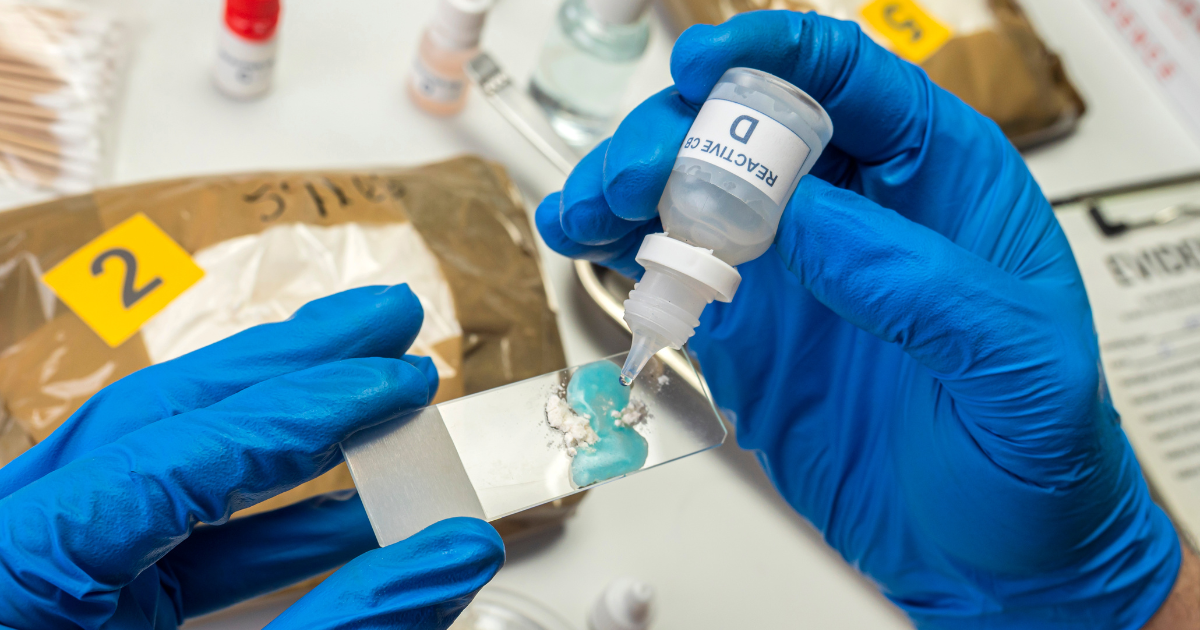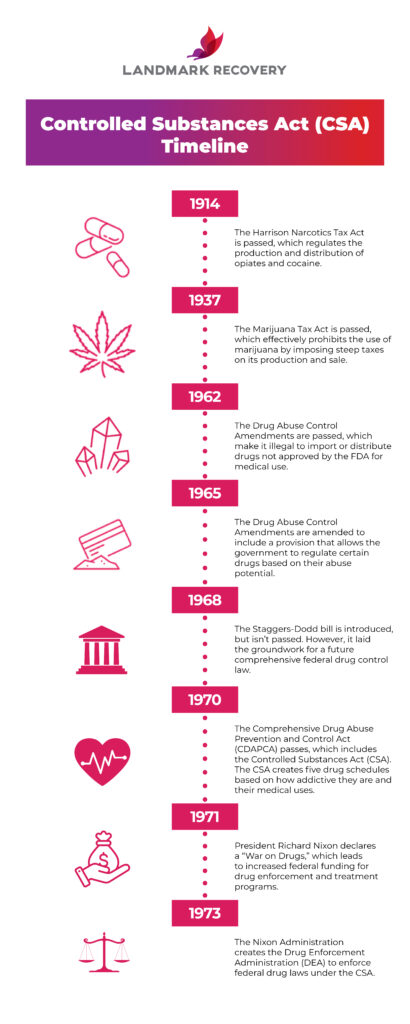For over 50 years, the Controlled Substances Act (CSA) has been a cornerstone of the federal government’s efforts to battle drug abuse and addiction. It regulates drugs according to how dangerous and addictive they are. The CSA also sets strict guidelines for who can access them, which is crucial as opioids, including prescription painkillers, heroin, and synthetic opioids like fentanyl, fuel an alarming trend of fatal drug overdoses in the United States.
In this blog post, we’ll examine the history of the CSA and explore how it prevents drug addiction across the United States.
Table of Contents:
- Definition of the Controlled Substances Act (CSA)
- History of the CSA
- DEA’s Role in Enforcing the CSA
- Overview of Drug Schedules
What is the Controlled Substances Act (CSA) & Why is it Important?
The Controlled Substances Act (CSA) – filed under Title II of the Comprehensive Drug Abuse Prevention and Control Act (CDAPCA) of 1970 – is a comprehensive federal U.S. law that regulates the manufacture, importation, possession, use, and distribution of certain drugs and chemicals that have the potential for abuse and dependence.
These drugs include:
- Narcotics (Opioids)
- Marijuana
- Stimulants
- Depressants
- Hallucinogens
- Anabolic steroids
The CSA created a system of drug scheduling that classifies drugs based on their potential for abuse, medical use and the severity of dependence they could cause. It also establishes penalties for drug-related offenses and provides guidelines for the manufacture, distribution and prescription of controlled substances.
History of the Controlled Substances Act (CSA)
Former President Richard Nixon signed the CSA into law on October 27, 1970, in response to America’s growing drug problem. Before that, drug control in the U.S. was a patchwork of state laws and regulations. There was no uniformity in the way drugs were regulated, and it was easy for people to obtain drugs illegally. The lack of uniformity made it difficult for law enforcement to track and prosecute drug crimes.
During the 1960s, drug abuse was also a major social issue, especially among young people. The recreational use of drugs like marijuana, heroin and LSD was on the rise in the United States, which led to substance use problems and addictions. There were also concerns about the safety and quality of drugs being illegally sold and trafficked on the black market.
As a result, Nixon declared a “war on drugs” in 1971, and Congress responded with the CDAPCA, which included the CSA. It was the first U.S. law to establish a single system of control for both narcotic and psychotropic drugs.
CSA Timeline
Here is a timeline of events that led up to the passing of the Controlled Substances Act (CSA):
- 1914: The Harrison Narcotics Tax Act is passed, which regulates the production and distribution of opiates and cocaine.
- 1937: The Marijuana Tax Act is passed, which effectively prohibits the use of marijuana by imposing steep taxes on its production and sale.
- 1962: The Drug Abuse Control Amendments are passed, which make it illegal to import or distribute drugs not approved by the FDA for medical use.
- 1965: The Drug Abuse Control Amendments are amended to include a provision that allows the government to regulate certain drugs based on their abuse potential.
- 1968: The Staggers-Dodd bill is introduced, but isn’t passed. However, it laid the groundwork for a future comprehensive federal drug control law.
- 1970: The Comprehensive Drug Abuse Prevention and Control Act (CDAPCA) passes, which includes the Controlled Substances Act (CSA). The CSA creates five drug schedules based on how addictive they are and their medical uses.
- 1971: President Richard Nixon declares a “War on Drugs,” which leads to increased federal funding for drug enforcement and treatment programs.
- 1973: The Nixon Administration creates the Drug Enforcement Administration (DEA) to enforce federal drug laws under the CSA.
Why is the Controlled Substances Act (CSA) Important?
The CSA is important for several reasons. First, it regulates access to highly addictive and dangerous drugs, preventing drug abuse and addiction. Secondly, it provides a unified framework for law enforcement to prosecute individuals involved in the illegal manufacture, distribution, or possession of controlled substances. Lastly, it permits the legal use of certain drugs for medical purposes under strict regulations and oversight.
Drug Enforcement Administration (DEA)
The Nixon Administration created the Drug Enforcement Administration (DEA) in 1973 to enforce the CSA’s regulations related to the manufacture, distribution and dispensing of controlled substances. The DEA accomplishes this by:
- Monitoring the import and export of controlled substances
- Working with international partners to combat drug trafficking
- Investigating and inspecting individuals and businesses involved with controlled substances
Legitimate manufacturers and distributors of controlled substances must obtain a registration from the Drug Enforcement Administration (DEA) and comply with strict record-keeping and security requirements. For example, the CSA requires healthcare providers who prescribe opioid treatment medications like buprenorphine to register with the DEA. Buprenorphine is a Schedule III narcotic with a low potential for misuse and addiction.
The DEA can prosecute CSA violators at the domestic and international levels.
Penalties
The CSA makes it illegal to manufacture, distribute or possess controlled substances without a valid license or prescription. The act also establishes penalties for drug-related offenses, including fines and imprisonment. Under the CSA, drug offenses are classified as either misdemeanors or felonies.
Misdemeanor offenses are less serious and are typically punished with fines and short-term imprisonment. Felony offenses are more serious and can result in longer prison sentences and heavier fines.
How the Controlled Substances Act (CSA) Classifies Drugs of Abuse
The CSA divides drugs and chemicals into five categories or schedules (I-IV) based on certain factors listed in Section 201 of the federal drug law. These factors include:
- Accepted medical uses
- Abuse potential
- Potential for mental or physical dependence
- History and current patterns of abuse
- Public health risks (if any)
- Current scientific knowledge on the drug or other substance
- Scope, duration and significance of abuse
- Whether the drug is an immediate precursor of a substance already controlled under
As the drug schedule changes, so does the abuse potential. For example, Schedule I drugs have the highest potential for abuse and addiction.
Schedule I
Schedule I (1) drugs and chemicals are considered the most dangerous. They have no accepted medical uses in the United States and the highest abuse potential.
Examples include:
- Heroin
- LSD
- Marijuana*
- Ecstasy
*Marijuana is still considered a Schedule I drug under federal law, despite several states legalizing recreational and medical marijuana.
Schedule II
Schedule II (2) drugs have a high abuse potential and are considered dangerous. They also have legit U.S. medical uses with restrictions.
Examples include:
- Cocaine
- Fentanyl
- Methamphetamine (meth)
- Oxycodone (OxyContin)
Schedule III
Schedule III (3) drugs have less abuse potential than Schedule I and II drugs. These drugs have currently accepted medical use in the U.S.
Examples include:
- Vicodin
- Testosterone
- Ketamine
- Tylenol with codeine
- Anabolic steroids
Schedule IV
Schedule IV (4) drugs have a low potential for abuse compared to Schedule III. Repeated use of a Schedule IV controlled substance could lead to low physical dependence or addiction.
Examples include:
- Ambien
- Valium
- Darvon
- Soma
- Darvocet
- Ativan
- Xanax
Schedule V
Schedule V (5) drugs have the lowest abuse potential. This drug schedule also contains a limited number of narcotics. These drugs usually don’t require a prescription and are sold over the counter (OTC).
Examples include:
- Lomotil
- Lyrica
- Parepectolin
- Cough syrups with limited codeine
Click here for the DEA’s alphabetical list of controlled substances.
Important CSA Takeaways
The Controlled Substances Act (CSA) plays a crucial role in regulating the manufacture and distribution of dangerous drugs. By grouping substances based on their abuse potential and creating penalties for drug-related offenses, the CSA has made it more difficult for people to obtain drugs illegally. The CSA has helped ease the risks associated with controlled substances. However, it hasn’t solved the problem of drug and alcohol addiction.
Substance use disorder (SUD) is a complex disease that requires comprehensive treatment, and Landmark Recovery is dedicated to providing integrated treatment programs to those in need. If you or someone you know is struggling with addiction, call 888-448-0302 for 24/7 support.
Visit our locations page to find a treatment center near you.

Choose Recovery Over Addiction
We're here 24/7 to help you get the care you need to live life on your terms, without drugs or alcohol. Talk to our recovery specialists today and learn about our integrated treatment programs.





